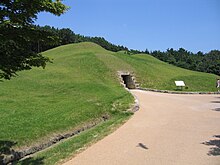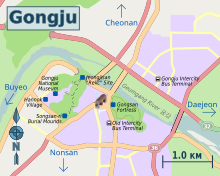The royal tombs of Songsan-ri
The royal tombs of Songsan-ri ( Korean : 송산리 ) consist of seven different tombs in Gongju ( 공주시 ), in Chungcheongnam-do ( 충청남도 ) Province , South Korea , dating from the Ungjin period (427-538 AD) of the Kingdom of Baekje ( 백제 ).
The tombs were placed under monument protection by the South Korean government in January 1963 as the 13th culturally significant site and on July 4, 2015, UNESCO added it to the list of World Heritage Sites under the title: " Baekje Historic Areas " .
geography
The tombs are located on a 75 m high wooded hill in the middle of the city of Gongju, 750 mm southwest and 1100 mm southeast of the Geumgang River ( 금강 ), which makes a right-angled left-hand curve at this point in the city. The area protected as a world cultural heritage is exposed and comprises 1.63 hectares , the protection zone around 20.46 hectares.
history
The royal tombs of Songsan-ri are also generally known as the royal tombs of Baekje or also as the tomb of King Muryeong , since only burial chamber number 7 is clearly a king, King Muryeong ( 무령왕 ), who died in 523 AD, could be assigned and also abundant grave treasures were found in the grave. Based on the construction and equipment, the graves are assigned to the Ungjin period and must all have been laid after AD 475, the year in which the seat of government and the main estate were moved from Baekje to Ungjin, today's Gongju.
The construction with carved stones and bricks was new in Baekje in its time and was adopted by the dynasties of southern China.
Archaeological research
Although the tombs were first examined by Japanese archaeologists in 1927 and then in 1932 and 1933 during the colonization of Korea by Japan , the tomb of King Muryeong was discovered by accident in 1971. The entrance to the grave was exposed when the drainage system was installed.
The tomb of King Muryeong is one of the few royal tombs in East Asia that have never been plundered by grave robbers and have thus been discovered, researched and evaluated in an original and well-preserved state.
At the time, the find also made clear the need for a systematic investigation of the site, which was carried out with the support of the government in 1988 (5th excavation). It unearthed three more mounds of earth and an altar. All grave objects are exhibited in the Gongju National Museum not far from the grave complex.
Public access
The outdoor area of the graves can be visited all year round during normal opening times, with the exception of a few festive days. The graves themselves are locked and the measure is intended to protect them from visitors and the weather. So that visitors can get a visual impression of the burial chambers, three of the graves have been faithfully reproduced.
In the years 2008 to 2012, an average of almost 383,000 visitors came.
literature
- Republic of Korea (Ed.): Nomination of Baekje Historic Areas . For Inscription on the World Heritage List . Seoul 2015, ISBN 978-89-299-0345-9 (English, online PDF 323 MB [accessed September 12, 2015]).
Web links
- Royal Tombs in Songsan-ri . Baekje Historic Areas Conservation and Management Foundation,accessed September 18, 2015.
- The Royal Tombs of Songsan-ri / Royal Tombs of Songsan-ri (Gongju). In: 1-2-3 Korea. Ralf Schymura, July 6, 2015, accessed on September 18, 2015 (blog with numerous photos of the graves and additional information).
- Songsan-ri Tombs and Royal Tomb of King Muryeong (UNESCO World Heritage) ( 송산리 고분군 과 무령왕 릉 유네스코 세계 문화 유산 ). Korea Tourism Organization,accessed September 18, 2015.
Individual evidence
- ↑ Nomination of Baekje Historic Areas . Seoul 2015, p. 135 .
- ↑ Korea: Baekjes historical sites listed as UNESCO World Heritage. In: Visit Korea . Korea Tourism Organization , accessed September 18, 2015 .
- ↑ a b Nomination of Baekje Historic Areas . Seoul 2015, p. 50 .
- ↑ Nomination of Baekje Historic Areas . Seoul 2015, p. 89 .
- ↑ Nomination of Baekje Historic Areas . Seoul 2015, p. 138 .
- ↑ Nomination of Baekje Historic Areas . Seoul 2015, p. 92 .
- ↑ Nomination of Baekje Historic Areas . Seoul 2015, p. 52 .
- ↑ Royal Tombs of Songsan-ri / Royal Tombs of Songsan-ri (Gongju). In: 1-2-3 Korea. Ralf Schymura, July 6, 2015, accessed on September 18, 2015 .
- ↑ Nomination of Baekje Historic Areas . Seoul 2015, p. 159 .
Coordinates: 36 ° 27 '38 " N , 127 ° 6' 46" E


